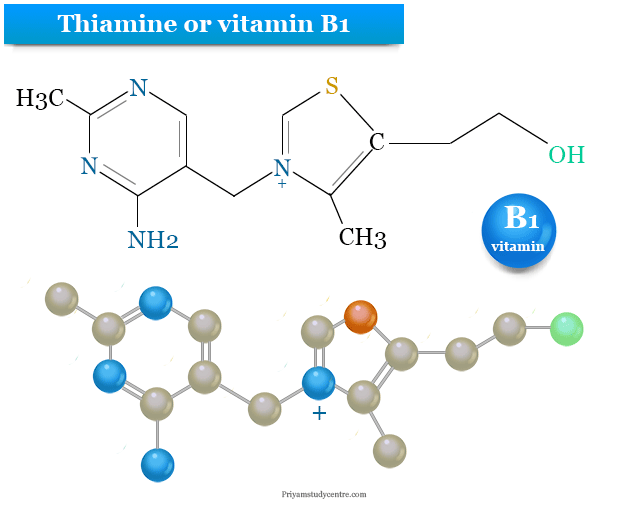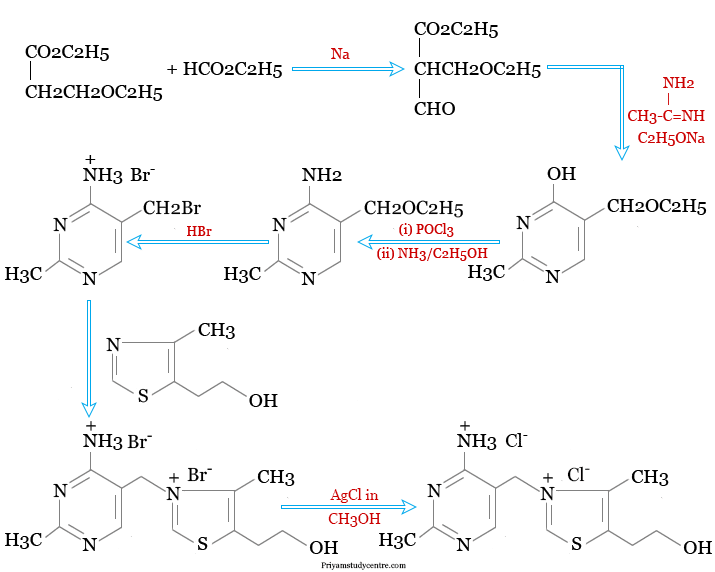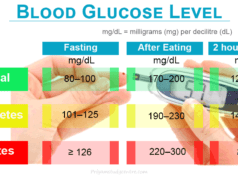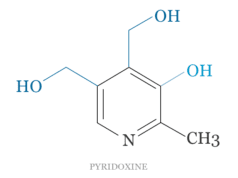Thiamine (Vitamin B1)
Thiamine or vitamin B1 is one member of the water soluble vitamin B complex found naturally in some foods or sold as a supplement. The deficiency of thiamine causes beriberi in humans. Therefore, it has antidiuretic properties. Rice polishing, yeast, and eggs are rich sources of thiamine or vitamin B1. It is required for the metabolism of glucose, amino acids, and lipids. It is a colorless crystalline organosulfur compound with the chemical formula C12H17N4O. Vitamin B1 is soluble in water, methanol, and glycerol and insoluble in less polar organic compounds. Thiamine occurs in all cells and plays an important role in the growth of the human body and controls various cell functions. It cannot be stored or produced by the human body.

Only a small amount of thiamine can be stored in our liver. Therefore, we need to intake thiamin-rich foods in our daily diet. The structure of thiamine or Vitamin B1 contains an aminopyrimidine and thiazolium ring linked by a methylene bridge. When chloride salt of vitamin B1 is treated with sodium sulfite saturated with sulfur dioxide at room temperature, it forms the following compounds,

The compound C6H9NOS obtained from thiamine chloride hydrochloride shows basic properties. The nitrogen atom in C6H9NOS is in a tertiary state. The functional nature of the oxygen atom is shown to be alcoholic.
The compound C6H9N3O3S is a pyrimidine derivative that contains a sulfonic group. When C6H9N3O3S is reduced with sodium in liquid ammonia, a sulphonic acid group is eliminated to form amino-dimethyl pyrimidine.
Thiamine Deficiency
It is used to treat thiamine deficiency which causes beriberi in man. Beriberi causes muscle loss and decreases feeling in the hands and feet. Other well-known disorders caused by vitamin B1 deficiency are:
- Wernicke–Korsakoff syndrome
- Optic neuropathy
- Leigh’s disease
- African seasonal ataxia, etc.
Thiamine deficiency in the United States and other well-developed countries is very rare because most of the people in these countries intake a sufficient amount of vitamin B1 in their daily diet. The most common signs of vitamin B1 deficiency are,
- Malaise
- Weight loss
- Confusion, irritability, and memory loss
- Muscle weakness
- Lowering immunity power
Other serious thiamine deficiency disorders like Wernicke–Korsakoff syndrome are caused by a high intake of alcohol. It may cause memory loss, muscle coordination loss, and peripheral neuropathy.
The risk of deficiency increases for the person who suffers from HIV/AIDS or diabetes or bariatric surgery. Doctors can treat thiamine deficiency by injecting a high dose of supplements through the vein with a balanced foods diet.
Thiamine Sources
It is an essential micronutrient for the growth and health of the human body. It is found naturally in several foods like whole grains, meat, and fish. Whole grains, legumes, pork, fruits, and yeast are rich sources of thiamine.
It can be added to bread, cereals, and baby foods in the United States and many other countries to fulfill the deficiency of thiamine or vitamin B1. The most common vitamin B1-rich foods are,
- Fortified breakfast cereals
- Pork
- Fish
- Beans, nuts
- Green peas
- Cereals, bread, noodles, brown rice
- Sunflower seeds
- Yogurt
- Squash, asparagus, and seafood
How to Get Thiamine?
It was discovered in 1897 and made first in 1936. It is an Essential Medicine according to the World Health Organization. The structure of thiamine has been confirmed by its synthesis. It can be done by the following process given below the picture,

The above synthesis methods have been used for the commercial production of vitamin B1.
Function
- Thiamine or vitamin B1 helps the functioning of the nerve, heart, and brain. In human cells, it helps to convert carbohydrates into energy. The main function of carbohydrates in the biological process is to provide energy to our bodies.
- It plays an important role in muscle contraction and nerve signals.
- Phosphate derivatives like thiamine pyrophosphate (TPP) or cocarboxylase are involved in many cellular functions. It requires the coenzymes for action and controls many other biological processes like the breakdown of pyruvic acid, alcoholic fermentation, and the reaction of acetaldehyde to carbon dioxide.
- It is essential for the metabolism of pyruvate. Pyruvate is an important molecule that participates in several chemical reactions in the biological system.
RDA Recommendation
The best way to get thiamine for our health is to intake it from daily dietary food sources. Several types of vitamin B1 supplements can be sold on the market.
Recommended Dietary Allowances (RDAs) of vitamin B1 for the United States are given below in the table,
| United States | |
| Age group | RDA (mg/day) |
| 0–6 months | 0.2 |
| 6–12 months | 0.3 |
| 1–3 years | 0.5 |
| 4–8 years | 0.6 |
| 9–13 years | 0.9 |
| Females 14–18 years | 1.0 |
| Males 14+ years | 1.2 |
| Females 19+ years | 1.1 |
| Pregnant/breastfeeding females 14–50 | 1.4 |
What is Thiamine Used For?
A low level or deficiency of thiamine causes different types of health problems like beriberi, certain nerve diseases, and Wernicke-Korsakoff syndrome.
We use several types of foods like yeast, cereal grains, beans, nuts, and meat in our daily diet which contains a rich amount of thiamine. It is important for us to break down carbohydrates into energy.
- We used thiamine injection to treat beriberi or serious conditions caused by prolonged lack of vitamin B1 in our daily diet.
- It is an important multivitamin used for the growth, development, and function of cells.
- It is used for the treatment of maple syrup urine disease and Leigh disease.
- In Western countries, thiamine deficiency is caused by a high intake of alcohol, HIV/AIDS, or diabetes.
- A high level of vitamin B1 is required for pregnant women or breastfeeding women due to the temporarily increased need for this nutrient.
- All organisms use vitamin B1 but it is made only in bacteria, fungi, and plants. Therefore, animals and humans can obtain thiamine from bacteria, fungi, and plants.








